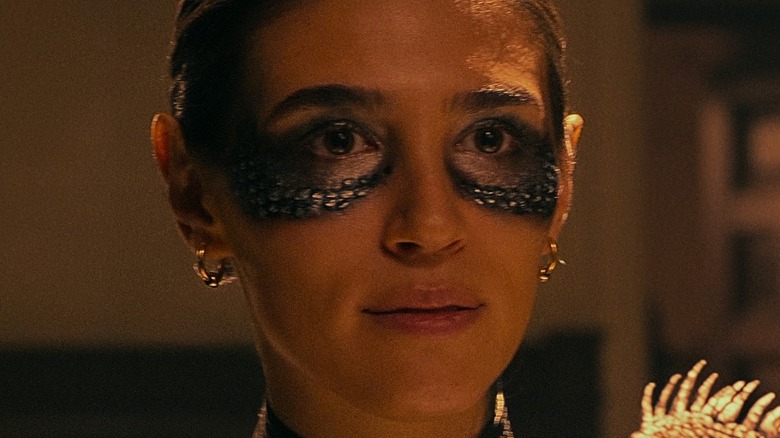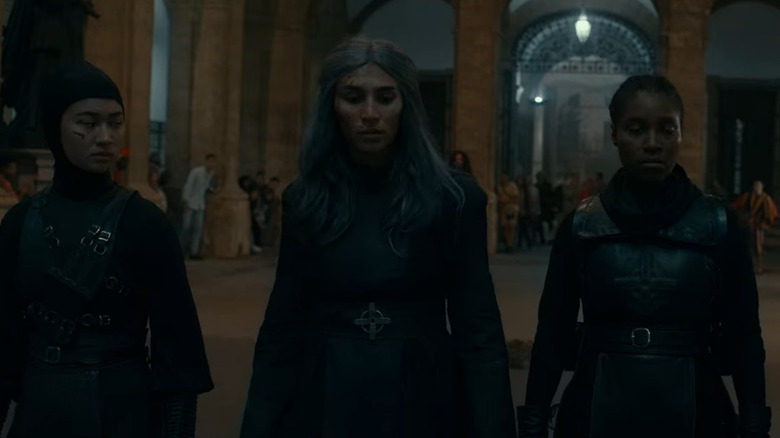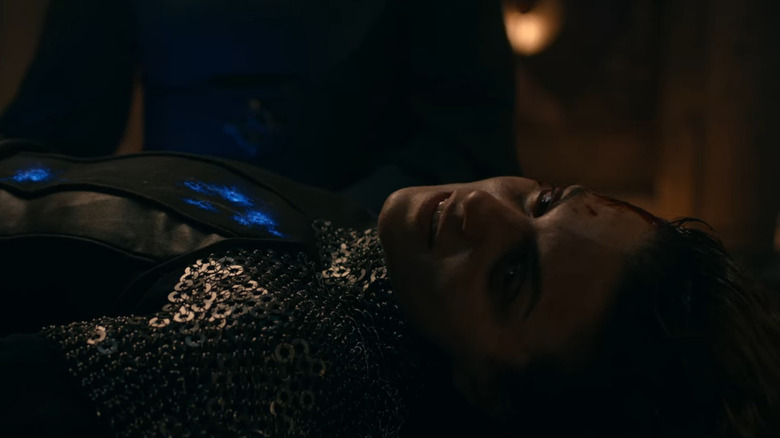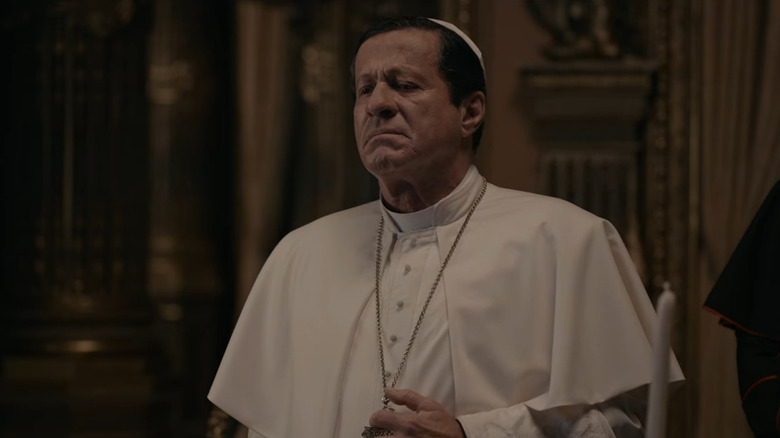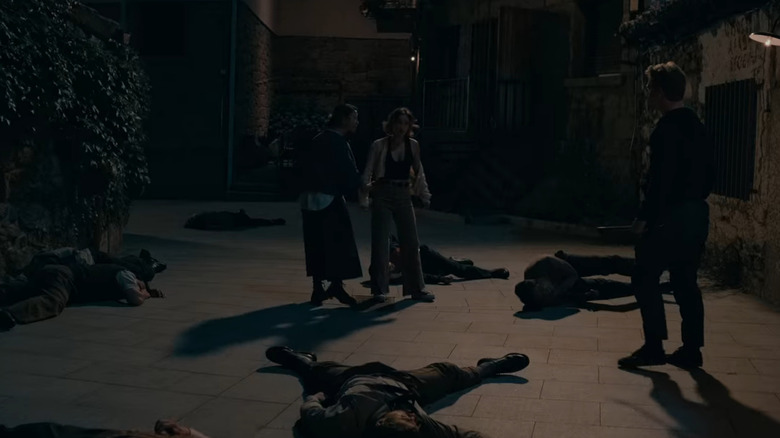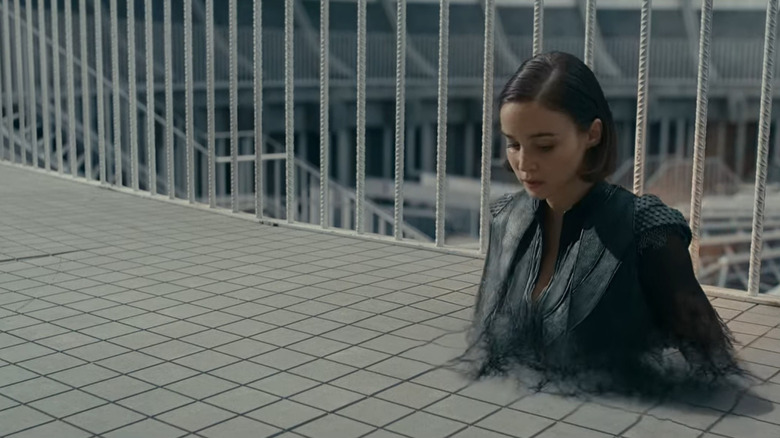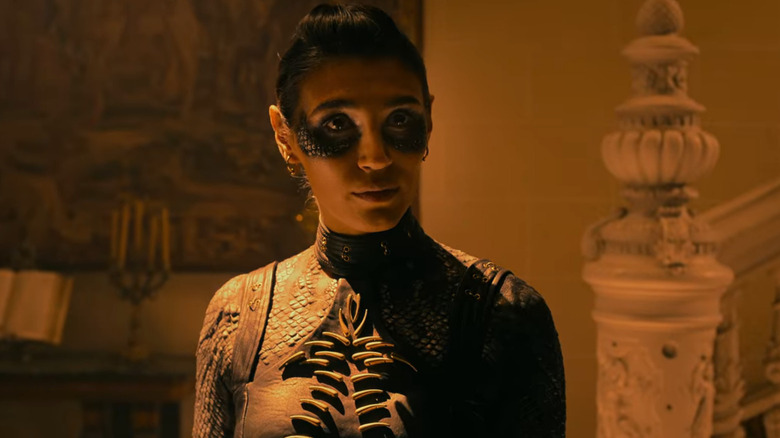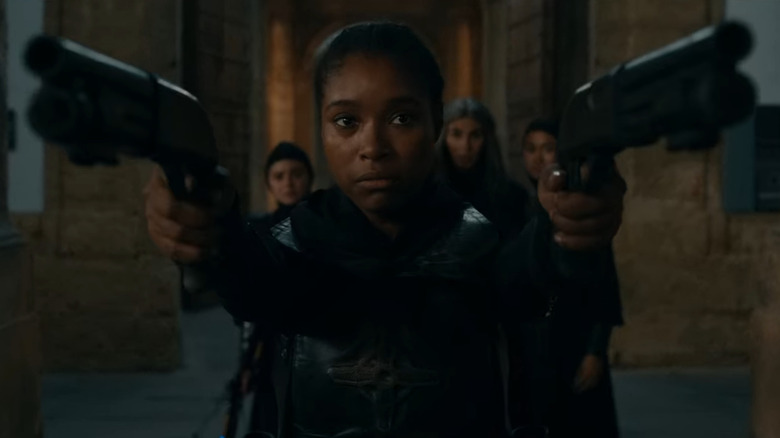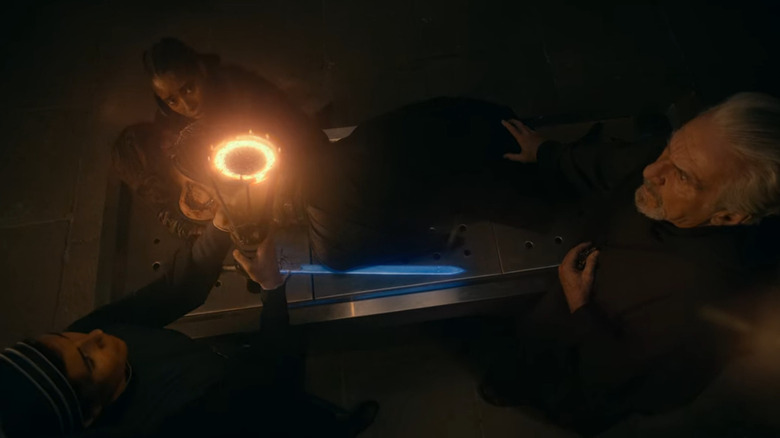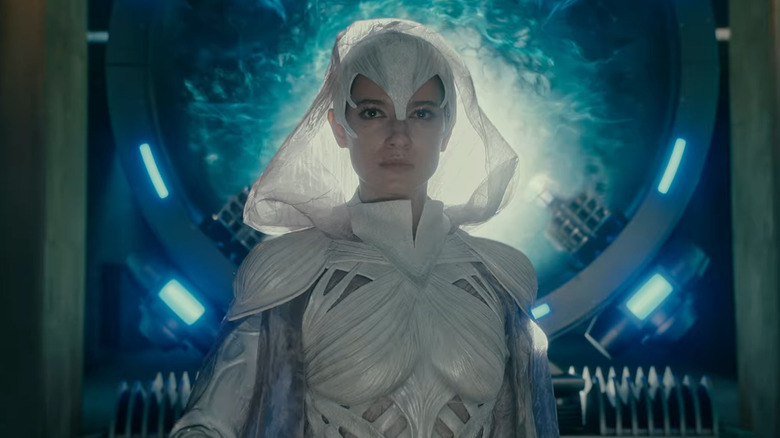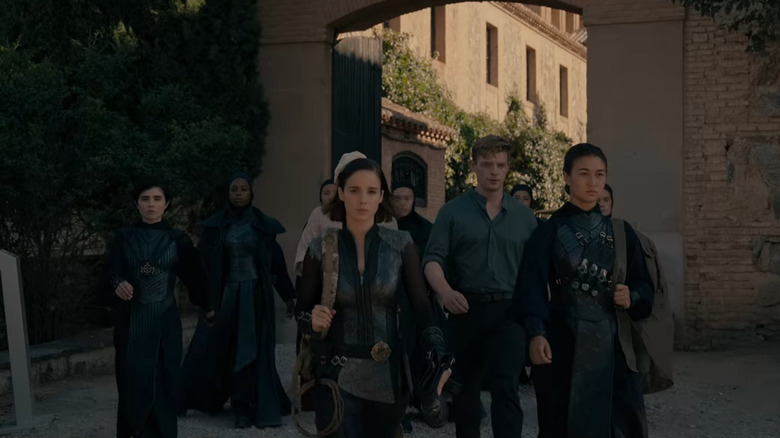Small Details You Missed In Warrior Nun Season 2
Spoilers ahead for "Warrior Nun" Season 2.
The second season of Netflix's "Warrior Nun" has wrapped on another exciting cliffhanger, and while the third season has yet to be announced, fans are settling in and hoping for more to come. With warrior nun Ava apparently sacrificing herself for the greater good, Beatrice striking out on her own, the nuns continuing on as a group, Adriel defeated, and Lilith just as much a wild card as ever, there's no shortage of potential directions for another season. Yet, for anyone who needs another dose of "Warrior Nun" sooner rather than later, there is plenty of material worth revisiting in the first 18 episodes of this tale of a gutsy warrior nun and the friends she meets along the way.
Perhaps unsurprisingly, a show titled "Warrior Nun" isn't particularly well known for its subtlety, and the season works well as an action-packed romp through biblical tropes told through a modern lens with a little touch of epic heroism thrown in for good measure. Yet, there are still some details that might surprise even the most fervent of fans; for instance, a surprisingly expansive comic book history, historical and biblical grounding, and more religious puns than you can shake a stick at. While we're waiting for more to come, here are the details that are keeping us up at night.
Fighting nuns are apparently a real thing
Many fans of the series may know that "Warrior Nun" is very loosely based on a comic series, but there are also literal warrior nuns in the world and they are just as intimidating as their fictional counterparts. In fact, the Kung Fu Nuns of Drukpa even have a solid online presence as well as a mission statement that feels well in line with the practices of the fictional Order of the Cruciform Sword that Ava joins forces with in the first season. Though not as superpowered, the Kung Fu Nuns are just as rad as the warrior nuns, and prioritize equity, tolerance, community activism, and human rights alongside their commitment to sporting top-notch martial arts moves and skills.
Likewise, the nuns of the original comic series have often been compared to the East Harlem chapter of the Fraternité Notre-Dame that sprang up in the early '90s, which was covered in the New York Times. Led by judo black belt Sister Marie Chantal, the order of nuns encouraged its members to take self-defense classes. Also noted for their anti-hunger efforts, this was another group with community service at the forefront of its mind. Though this sect seems significantly more casual at its root than the coordinated interest in martial arts of the Drukpa order, it's still pretty clear that the notion of warrior nuns wasn't exactly an idea that was born in a void.
The comics are a little bit of an afterthought
You might be surprised to know that the "Warrior Nun" TV show has very little to do with "Warrior Nun Areala" comics. More or less taking what it needs from the premise and moving forward to become its own thing, the Netflix series made a few fairly brilliant decisions in freeing itself from the comics' continuity. Introducing the main character of the comics, Sister Shannon, in the first moments of the first episode to grant her a suitably heroic demise lets the show give a nod to what came before without being beholden to '90s action hero tropes that wouldn't fit on a modern Netflix show. Another comics-relevant detail is the gender-swapped Jillian Salvius, who's a man named Jullian in the comics.
While the comics are often understandably dismissed as being very much of their time, there is still something to be said for the impact the series had on the comics industry in its day. Though there is obvious controversy around the series due to its abundance of scantily clad nuns, the fact is that it did well enough to warrant several different mini-series and even its own 19-issue ongoing in 1999.
Episode titles are thematically relevant Bible excerpts
Many fans of the first season of "Warrior Nun" noticed that the episode titles, named after Bible verses, often contain Easter eggs foreshadowing events to come. The second season continues this practice, beginning with the first episode. Episode 1 is titled "Galatians 6:4-5," and the corresponding biblical excerpt reads, "But let every man prove his own work, and then shall he have rejoicing in himself alone, and not in another. For every man shall bear his own burden." Ava's lowkey training in response to the chaotic heroism of the first season and her attempts to lead a normal life put the title in perspective.
Likewise, the final episode of the season, titled "Jeremiah 29:13," indicates not only the way that an overreliance on deception makes Adriel weaker than he might otherwise be, but that Ava has finally come to accept her role as a vessel in service of the greater good. The verse reads in part, "You will seek me and find me when you seek me with all your heart." Indeed, Ava's quest first sees her fighting against the role of giving her life in service of others, but she embraces it this season due in no small part to her love for Beatrice. She confesses that her sacrifice is made so that Beatrice will be able to lead a full life, and because of this, it's made willingly, or "with all her heart," in other words.
There's a lot less inner monologuing
Though the second season of "Warrior Nun" proves very much a continuation of the characterization and themes set forward in the first season, there is one notable change. Ava's inner monologues were cut to the point of being relatively nonexistent, which may serve as a bit of a change of pace for anyone who grew accustomed to her ongoing stream of consciousness in the first season. Though opinions around the monologues in the negative or affirmative alike may boil down to simply being a matter of taste, there's no questioning that the second season has a different feel without them.
Rather than consistently giving us a bird's eye view on Ava's somewhat chaotic inner monologue, the second season distilled them into brief moments often placed toward the beginning of episodes if they're included at all. Though Ava's voice is clearly defined as a result of her telling us what's going on in her head, the fact is, going into the second season, we didn't need the explainers all that much. Instead, their absence allows us to intuit what Ava is thinking while opening up the floor to hearing other voices along the way. If anything, the second season feels more like an ensemble rather than one young woman's tale, and that is no doubt in part due to the creators easing up a bit on Ava's admittedly often entertaining inner world.
It got more violent
The first season of "Warrior Nun" has quite a few fight scenes to be sure, but there's no denying that there's a pretty sharp increase in action sequences this round. While Ava's powers and relative lack of training initially keep her from engaging in the nitty gritty of hand-to-hand combat, the other nuns are pleased to step in to fight demons where they were needed. However, with the second season, we see from the very start that Ava is training with Beatrice in hopes of becoming a more skilled fighter, noting that the power of the Halo alone won't be enough to defeat Adriel.
While the nuns attempt to regroup or rally after insurmountable attacks during the first episodes, each of them steps into action in ways that show us a lot more of what they can do this season. Camila gets the drop on Adriel with a crossbow, Mother Superion puts her life on the line to protect the Pope, Sister Dora steals every scene she's in by being an action star in her own right, and even Yasmine has a heroic moment of her own when a man attempts to take her hostage after assuming she'll be an easy mark.
However, perhaps the standout of the season when it comes to nonstop stellar fight scenes is Beatrice, who single-handedly takes on entire crews of Adriel's followers with a level of calm assuredness that would terrify us if we weren't pretty sure she'd be on our side.
In a way, the location is a character
Like most Netflix series, "Warrior Nun" has a relatively modest budget, and therefore tends to rely on a number of supporting elements to add an element of the epic. In fact, "Warrior Nun" does incredible work when it comes to simply utilizing what it has. Though its special effects and CGI tend to be serviceable rather than especially impressive, its lean into riveting fight scenes, methodical characterization, and its ability to work with the incredible scenery built into its filming location more than balances this out.
So much of creating a perfect show relies on acknowledging limitations and using them to your advantage, and that is something that "Warrior Nun" absolutely succeeds in. Throughout both seasons, the backdrop of Spain allows the creators to lean into the gorgeous cathedrals and breathtaking scenery intrinsic to the region to do a lot of heavy lifting. Likewise, though Adriel's Cathedral is a unique sci-fi structure, one gets the feeling that it's supposed to have an element of unreality to it — in other words, if it doesn't look "real," that's the idea. Even at that, Adriel's Cathedral is mostly used as a backdrop for one of the most epic combat sequences of the series as Ava faces off against her former friend Lilith, which prevents us from spending too much time wondering about the functionality of the structure.
Lilith is aptly named
While beloved antihero Lilith has a number of obvious flaws, there is certainly a charm to her no-nonsense clarity of vision. A legacy nun originally intended to receive the Halo only to be shattered when she's passed over for it in favor of Ava, our girl spends much of the first season with her interests torn. Quite understandably, she struggles to reconcile her new lack of purpose and feelings of being used by an organization that she gave her life to.
The second season continues this journey by showing her undergoing an epic demonic transformation, fighting Ava to a standstill multiple times, siding with the villainous Adriel, and ultimately giving Beatrice the idea to save Ava's life by pushing her through the Arc. If there's anything we've learned, it's that we have legitimately no idea what Lilith is going to do next. For the theologians in the audience, this will ring true of the biblical Lilith, often considered to be the first wife of Adam before they rejected each other and she left Eden forever (the details of this origin change and are necessarily abbreviated here). Though often considered monstrous in myth, Lilith has been embraced in feminist retellings, leading us to believe that the naming of this character might not have been a coincidence.
Mary left the show between seasons
The first couple of episodes of the second season of "Warrior Nun" show Lilith on the search for Shotgun Mary, one of the central characters of the first season last seen being overwhelmed by Adriel's followers. This teases the hope that we may see her again, though we are ultimately told that she is gone. There is a bit of vagueness around the wording here, and we're not totally dismissing the possibility of her return, but the second season certainly left a Shotgun Mary-sized hole in our lives. The nuns feel much the same way; the core group struggles while Lilith leaves the organization entirely after learning of Mary's apparent demise.
According to showrunner Simon Barry in an interview with Cosmopolitan, Mary's departure was equally surprising behind the scenes, which is why it feels inordinately abrupt. Toya Turner, the actor that portrays Mary, left "Warrior Nun" due to personal circumstances, so it makes sense that the series may have made story changes on the fly after the announcement. Turner is an incredible performer, so we won't say that she wasn't missed, but the introduction of several new nuns in the second season helped ease the pain. We're still hoping for a surprise return, but for now, all we can say is "R.I.P. Mary, we loved watching you fight demons."
The Halo might be fully sentient
Speaking of this Halo that everyone is so concerned about, what exactly is its deal? So far, we know that it was brought to our dimension by Adriel, who hid it in Areala to throw off its scent from the demons using it to hunt him after his arrival on Earth. Since then, it has been passed from generation to generation, with each warrior nun gifted with its powers equally doomed to experience a way-too-early demise. We first see the Halo removed from Shannon's back as she perishes, then it's hidden in the deceased body of Ava, who is chosen and resurrected as its bearer. This is a lot for a hot piece of metal to accomplish, and we've got some questions.
What we've learned about this incredible tool over the last two seasons could just about fill a thimble, but one thing we know for sure is that it possesses some level of sentience that allows it to choose or reject its bearer. Indeed, over time, we see that the people the Halo rejects are just as well curated as those that it chooses — Mother Superion loses it after making a series of reckless mistakes and Lilith gets passed over only to go off on her own journey away from her former sisters. The Halo seems to have basic communication with Ava, though we haven't seen the extent of that quite yet. As usual, we're dying to hear more.
Is Reya the true villain?
Reya is the apparent ruler of a whole entire realm, known as The Other Realm, which requires the use of Jillian's Arc to access. We know concerningly little about what is going on with this otherworldly portal — Michael vanishes into it and emerges a grown man a few weeks later but doesn't offer much insight on what goes on in there. We know that even with the Arc, the realm is more likely to reject a person than accept them, which is exactly what happens when Jillian casually sends Lilith right on over just to be spit back out in a matter of minutes. She insists that whatever that place is, she certainly isn't welcome there.
Lilith has her issues, but we know that she's possessed of extraordinary insight. Indeed, when she sides with Adriel, it might be a betrayal to her former friends, but for her part, it's a highly tactical move as he appears to be the only one capable of helping her. At a certain point, Adriel notes that he and Ava are actually on the same side in a cosmic war that she knows very little about. This could be a last-ditch attempt at manipulation, or he could actually be telling the truth for once. It's difficult to know where things will go from here.
Cliffhangers are becoming a theme
The conclusion of the first season of "Warrior Nun" is an indisputable banger that pulls out all the stops for a shocking finale. After being misled by the morally ambiguous Father Vincent into freeing the supposedly angelic Adriel, Ava is stunned by the realization that Adriel is actually a demon with his sights set on global domination. We discover that Vincent actually killed Shannon, which is why she attempted to warn Mary not to trust "anyone" in the first episode. A lot goes on in the Season 1 finale; Mary is overwhelmed by Adriel's followers, and Jillian loses her son to the Arc. Some TV shows settle on only two or three gut punches an episode — meanwhile, that finale hit some of us so hard that we had to call out for work the next day.
The end of "Warrior Nun" Season 2 lives up the precedent of the first finale. At first, it lulls us into a relative sense of security as Beatrice and Ava relentlessly train and flirt with each other in equal measure, hoping to eventually stop Adriel themselves. Naturally, plenty of things occur to make this a lot harder than it sounds on paper, and it all ends with Ava making a heroic sacrifice and possibly ending her tenure as both the warrior nun and a living person on this earth. Like Vincent, Lilith fluctuates loyalties, Adriel apparently perishes, Beatrice walks away from the convent, and we're left with a final shot of the sword glowing with power. Season 3 can't come soon enough.
